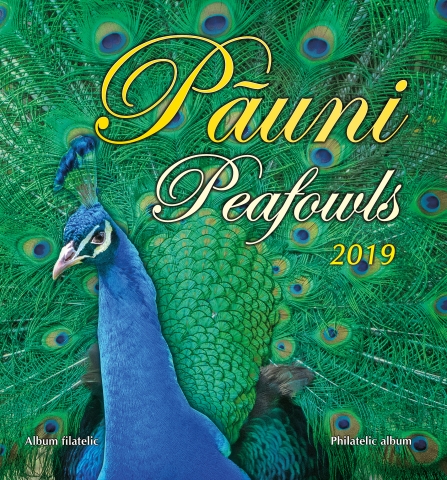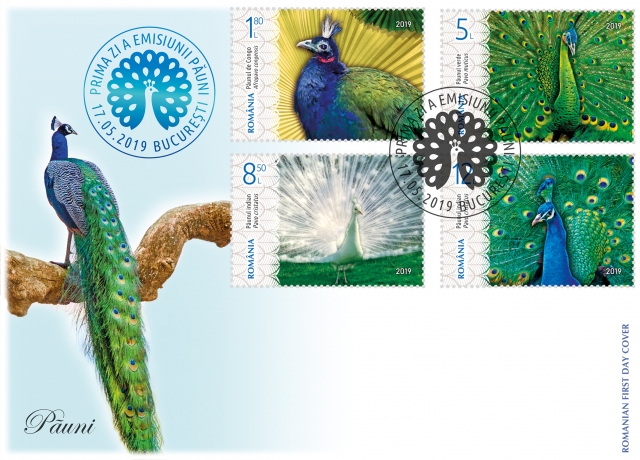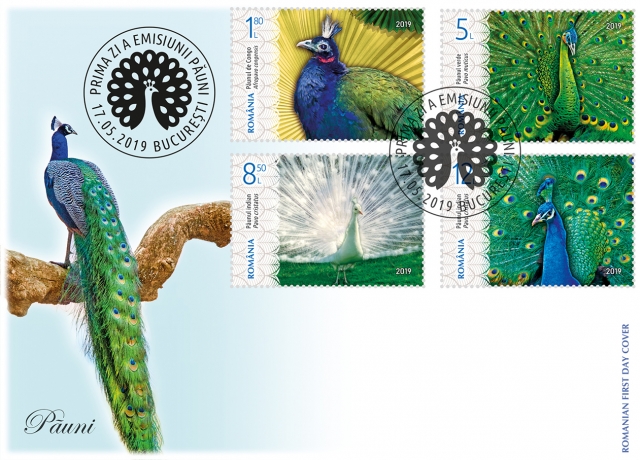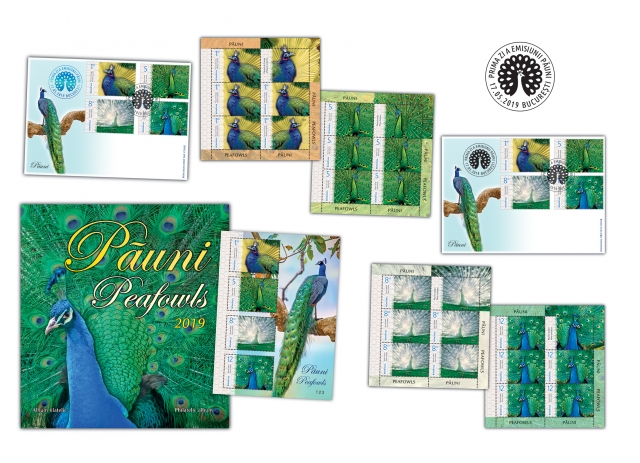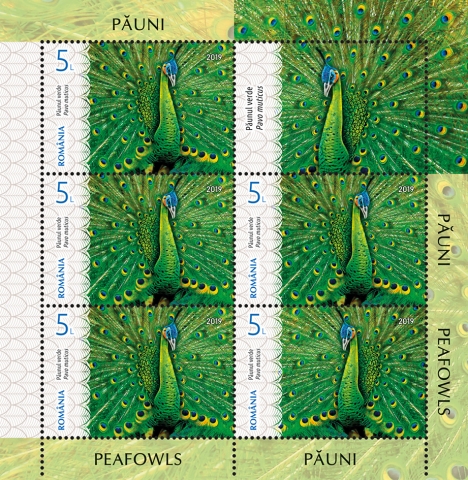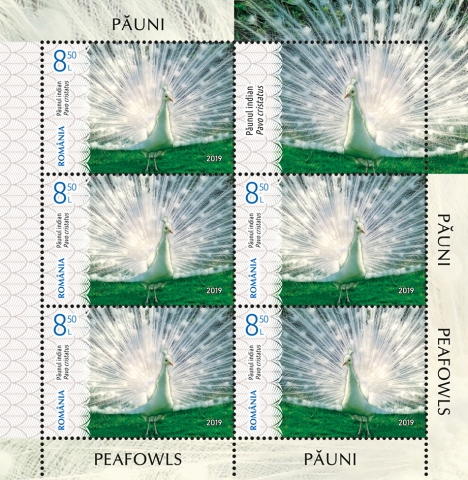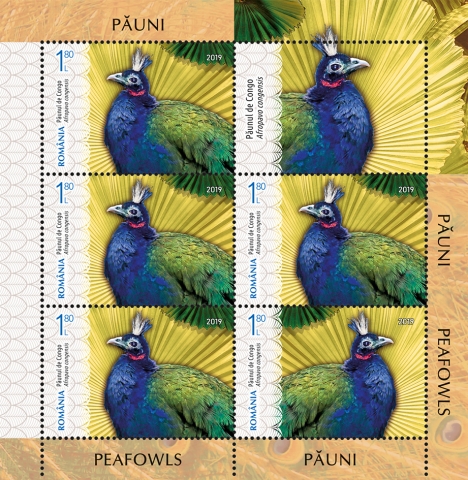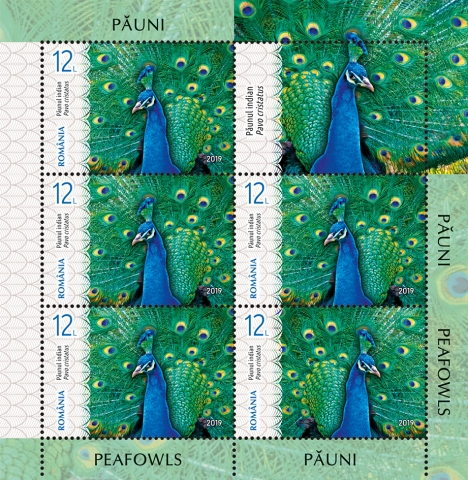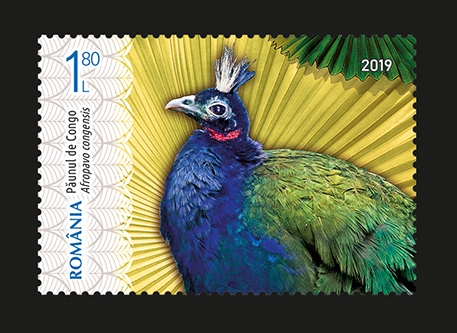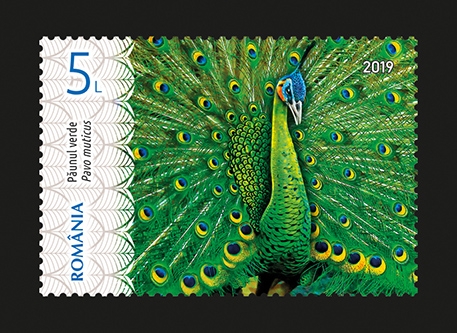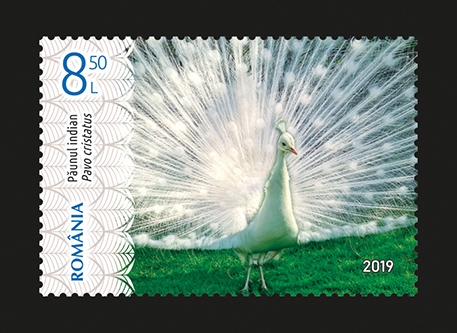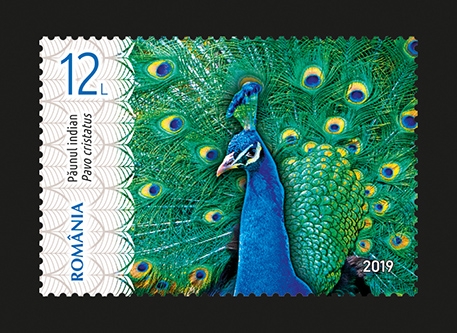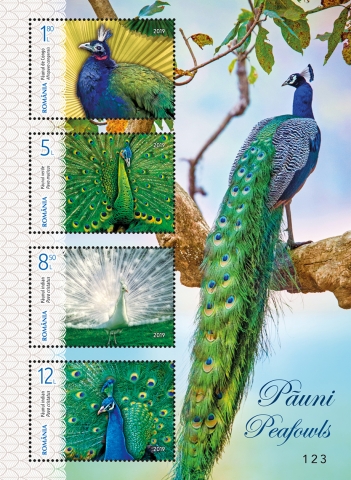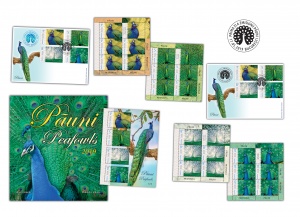 Romfilatelia introduces into circulation a postage stamps issue with the title “Peafowls””, on Friday, May 17th, current year.
Romfilatelia introduces into circulation a postage stamps issue with the title “Peafowls””, on Friday, May 17th, current year.
The Peafowls theme fits into the preferences of postage stamps collectors and this new issue will complete their collections with the images of four special specimens of the species.
Peafowls are named in the Indian mythology the “the gods’ vehicles”, because the legend says that Shiva’s son, Karthikeya, is represented flying on the back of a peafowl.
The peafowl originates in Sri Lanka and India, but the beauty of its plumage has made it spread even in other parts of the world, being adopted as an ornamental bird. In other times, the peafowls were a symbol of opulence, being present in the gardens of European noble families. The male’s tail is the element that defines the exotism of the species and the main reason they are known throughout the world. Besides the multi-coloured plumage, they distinguish by their intense cries and elaborate mating dance. The peafowl is a solitary bird, diurnal, and sleeps in the trees to protect itself from predators.
It is one of the largest flying birds, but spends more time running, than flying. The average lifespan of the peafowls in captivity is 25 years, and in the wild they live to the age of 30 years. Peafowls are omnivores, and their diet consists of plants, ants, seeds, locusts, termites, ticks, petals of flowers, reptiles, amphibians and arthropods.
The Congo peafowl or the African peafowl (Afropavo congensis) is spread in the tropical rainforests of the Congo River, and is illustrated on the first postage stamp of this issue, with the face value of Lei 1.80. This type of peafowl has a large-size apperance. The length of the male is up to 70 cm, with a short tail measuring between 23-26 cm and the females have dimensions between 60-63 cm, with a tail between 19.5 and 22.5 cm. The difference in weight between the sexes is considerable, the males weighting 1,475 g, and the females weighting 1,154 g.
Their plumage is special, with white stripes on the crown, some specimens having their neck partially discovered.
Their habitat is varied, usually choosing lower areas below 1,200 m in altitude, being very difficult to spot in the wild.
The green peafowl (Pavo muticus) is part of the peafowl family (Phasianidae), the Galliformes order, originating in India, Sri Lanka, Pakistan, Bhutan, Bangladesh or Nepal, and is represented on the second postage stamp of this issue, with the face value of Lei 5.
It is divided into three races: Pavo muticus spicifer, pavo muticus imperator Delacour and Pavo muticus Linnaeus, the races having varied colour feathers, an element through which they are differentiated.
The males measure between 180 and 250 cm, with a tail that can be between 140 and 160 cm.
Their weight varies between 3,850 g and 5,000 g. Females measure 100-110 cm, with a tail that can reach up to 45 cm. Females resemble males, but they have shorter legs and do not have the plumage so brightly coloured, a feature which makes them very difficult to confuse.
They set up in open forests or at their periphery, but avoid tropical forests, preferring a habitat at altitudes ranging from sea level up to 3,000 m.
The Indian peafowl (Pavo cristatus) is of a legendary beauty, declared the national bird of India, known in two colour variants: blue and white, the subspecies being represented on the third and fourth postage stamp of the issue with the face values of Lei 8.50 and Lei 12. It is part of the family of peafowls (Phasianidae) and of Galliforme order, originating from India.
Males at adult age have a length of 180 to 230 cm, their tail measuring between 140 and 160 cm and their weight ranging from 4,000 to 6,000 g. The wingspan of this species varies between 130 and 160 cm. Males have a distinctive morphological appearance, and their open tail is in the shape of a fan.
Females are smaller and measure between 90 and 100 cm, with a tail measuring between 32.5 and 37.5 cm, with an average weight of 2,750 to 4,000 g. The wingspan of the females is from 80 to 130 cm.
There are varieties of the indian peafowl feathers. One of the most spectacular indian peafowls is the white peafowl, which is not albino, but is a pure species, with hazel eyes.
The indian peafowls choose to set up in open forest areas with shrubs, but at an altitude of up to 2,000 m.
Romfilatelia thanks National Museum of Natural History “Grigore Antipa” for the documentary support granted to the achievement of this postage stamps issue.
The postage stamps issue Peafowls will be available on Friday, May 17th 2019, in Romfilatelia’s shops network in Bucharest, Bacau, Brasov, Cluj-Napoca, Iasi and Timisoara and online on https://romfilatelia.ro/store/. The postage stamps issue is completed by 1 “first day” cover, and as page composition, in sheet of 32 stamps and minisheet of 5 stamps + 1 label.
For further information, please contact the Public Relation Office:
Tel: 021 / 337 24 42



